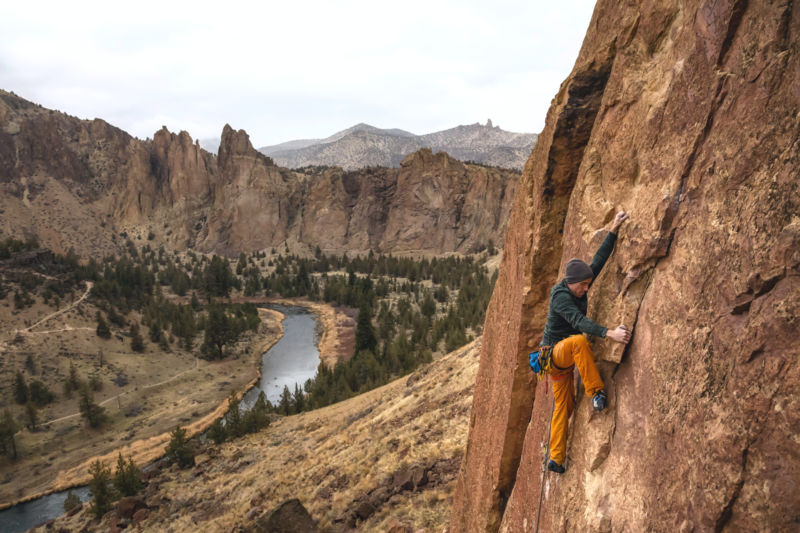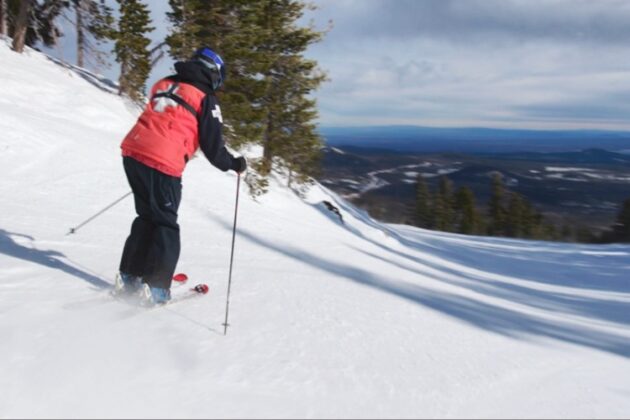
Rock climbing and bouldering are popular sports in Central Oregon. It’s no surprise since the birthplace of American sport climbing, Smith Rock State Park, is located just 30 miles north of Bend. In addition, there are many other outdoor and indoor options available for climbers of all abilities. While there is always a risk of falling or traumatic injury in this sport, avid climbers more frequently experience overuse injuries at some point in their climbing careers.
Shoulder Injuries
Rotator cuff injuries are common for climbers because of the amount of time they spend with their arms overhead pulling up their body weight. The rotator cuff provides stability for the shoulder. It is comprised of tendons in the shoulder that attach to the humerus, as well as the four major muscles that surround the shoulder joint. A weak rotator cuff and/or poor biomechanics can contribute to a tear or tendonitis. Common symptoms include pain, weakness when lifting or lowering the arm, limited range of motion, and hearing clicking or popping sounds.
Treatment for Rotator Cuff Injuries
Conservative treatment can be effective in treating tendonitis and small tears. This includes rest, ice, anti-inflammatory medications, corticosteroid injections, or physical therapy. If symptoms don’t go away or there is a large rotator cuff tear, surgery may be necessary to repair the tendon.
Elbow Injuries
Tennis elbow, or lateral epicondylitis, is an inflammation of the tendons that join the forearm muscles on the outside of the elbow. Because climbers use motions that include repetitive gripping and lifting, this is another common overuse injury. Symptoms include tenderness on the outside of the elbow, pain or weakness when using the affected elbow, and pain with resistance.
Treatment for Tennis Elbow
Most cases of tennis elbow can be resolved without surgery. Conservative treatment options include rest, ice, anti-inflammatory medications, bracing, or physical therapy. If symptoms do not improve over 6-12 months, your doctor may advise surgery to allow you to return to comfortable, normal activity.
Finger Injuries
Rock climbers use an excessive amount of force on their fingers, especially when a climber’s foot slips and their hand grip tightens. An A2 pulley strain is the most common finger injury for climbers and most often occurs in the ring or middle finger. Each finger has tendons and ligaments that helps the finger bend, move, and grip. This network of tendons and ligaments runs under a sheath called a pulley that helps hold them near the bones of the fingers. There are five pulleys on the palm side of every finger. The A2 pulley is located in the first finger segment (proximal phalanx) closest to the palm. The most common symptom is hearing or feeling a pop in the finger while pulling down, followed by pain, bruising, swelling, and difficulty forming a fist. Injuries can range from a mild sprain or a complete tear. Rest, ice, splinting, and physical therapy are common treatment options. After the pulley heals, most people use tape on that finger to provide additional support when climbing.
Treatment for Flexor Tendon Tear
The flexor tendons that run underneath the pulleys can also tear or stretch when climbing. When a flexor tendon tear occurs, pain is felt between the palm and the wrist, as well as tenderness, numbness, and an inability to bend one or more joints in the finger. Surgery is often necessary to repair complete tendon tears.
Collateral ligament strains usually occur with sideways loading, such as when you are throwing one hand out to a hold with the other. It most commonly occurs in the middle joint of the middle finger. The collateral ligaments surround each finger joint. Symptoms include pain, swelling, and tenderness at one or both sides of the finger joint. Treatment for this type of strain is usually nonsurgical and includes rest, ice, anti-inflammatories, and taping the finger for support.
Trigger finger is a common overuse injury that occurs when the flexor tendon becomes irritated and begins to thicken, eventually creating nodules that make it difficult for the joint to bend and straighten.
Treatment for Trigger Finger
If symptoms are mild, your doctor may suggest resting the finger or placing it in a custom splint. If there is pain and discomfort, taking a non-steroidal anti-inflammatory medication or injecting the area with corticosteroid can be effective. If pain does not subside after conservative treatment, surgery may be recommended.
Wrist Injuries
The most common wrist injury in climbers occurs when there is damage to the triangular fibrocartilage complex (TFCC). This is a cartilage structure located on the pinky side of the wrist that sits between the end of the ulna (forearm bone) and the carpal bones of the wrist. It provides stability and support when the hand grasps or the arm rotates. When a climber feels the onset of wrist pain and continues to climb, the TFCC can degenerate and even tear. Symptoms include a dull, achy pain on the side of the wrist and sometimes a sharp pain is felt when bending the hand toward the pinky finger.
Treatment for Triangular fibrocartilage complex (TFCC).
When diagnosed early, rest, anti-inflammatory medication, and using a splint can typically heal the injury. After the TFCC heals, taping the wrist while climbing can help provide additional stability and support, as well as prevent re-injury. In more severe cases, surgery is necessary to remove the damaged tissue and clean off the torn edges; this is also known as debriding. Recovery from this procedure includes wearing a cast for several weeks followed by physical therapy to regain range of motion and strength.
What causes climbing injuries?
Climbing injuries are caused by a variety of factors including but not limited to the following:
Overuse Injuries:
- Finger and Hand Injuries: Climbers frequently place a lot of stress on their fingers and hands, especially when gripping holds tightly. This can lead to conditions like pulley strains or tears, tendonitis, and overuse syndromes like climber’s elbow or wrist tendinitis.
- Elbow Injuries: Elbow injuries, particularly medial epicondylitis (also known as golfer’s elbow), can occur due to repetitive stress on the tendons that connect to the inner side of the elbow. This can be aggravated by frequent gripping and pulling motions.
- Shoulder Injuries: Climbing can place significant strain on the shoulders, particularly in moves that require overhead reaching or dynamic movements. Overuse or poor technique can lead to conditions like rotator cuff injuries or impingement syndrome.
- Back and Spine Issues: Prolonged arching of the back or twisting movements can lead to strains, sprains, or even more severe spine-related injuries.
Inadequate Warm-Up or Stretching:
- Muscle Strains: Without proper warm-up and stretching, muscles may not be adequately prepared for the stress of climbing. This can lead to strains, particularly in the legs, back, and upper body.
- Limited Range of Motion: Inadequate stretching can limit a climber’s range of motion, potentially leading to awkward movements and increased risk of injury.
Inadequate Training or Technique:
- Muscle Imbalances: Inadequate training can lead to muscle imbalances, where some muscles are stronger than others. This can lead to overuse injuries or improper movement patterns.
- Improper Weight Distribution: Failing to distribute weight properly during climbs can lead to unnecessary strain on certain muscle groups, potentially causing injuries.
- Foot Placement and Technique: Incorrect foot placement or not utilizing proper techniques for balance and stability can lead to slips, falls, or putting excessive strain on leg muscles.
To mitigate these risks, climbers should focus on building strength and flexibility in a balanced manner, engage in specific training to target climbing-related muscle groups, and practice proper climbing techniques. Additionally, incorporating warm-up routines and regular stretching can help prevent overuse injuries.
How to prevent climbing injuries?
Preventing common climbing injuries requires a combination of physical conditioning, proper technique, and careful attention to safety measures. Here are some key strategies to help minimize the risk of injuries while rock climbing:
Gradual Progression and Conditioning:
- Start with climbs that match your current skill level and gradually progress to more challenging routes.
- Incorporate strength training and flexibility exercises focused on the muscles used in climbing, including fingers, forearms, shoulders, core, and legs.
Proper Warm-Up and Stretching:
- Begin each climbing session with a thorough warm-up to increase blood flow and prepare muscles for the demands of climbing.
- Incorporate dynamic stretches that target key muscle groups, including wrists, forearms, shoulders, and lower body.
Technique and Form:
- Seek instruction from experienced climbers or certified instructors to learn proper climbing techniques, including footwork, balance, and efficient movement.
- Focus on precise hand and foot placements to reduce unnecessary strain on muscles and tendons.
Listen to Your Body:
- Pay attention to any signs of fatigue, discomfort, or pain. Rest when needed and avoid pushing through excessive strain.
- Recognize the difference between normal muscle fatigue and the early signs of overuse or acute injuries.
Use Quality Gear and Check Equipment:
- Regularly inspect and maintain climbing equipment, including harnesses, ropes, carabiners, and belay devices, to ensure they are in good working condition.
- Invest in high-quality climbing gear from reputable manufacturers to minimize the risk of equipment failure.
Rest and Recovery:
- Allow for adequate rest days between climbing sessions to give muscles and tendons time to recover and repair.
- Incorporate active recovery techniques like stretching, foam rolling, and gentle exercises on rest days.
If you experience an injury while climbing, it’s crucial not to delay seeking care. Our team of upper extremity specialists is dedicated to evaluating and addressing climbing-related injuries. For immediate care, visit our NOWcare walk-in clinic, available Monday through Friday from 8:00 A.M. to 4:00 P.M.
Keep up to date on future webinars and events and receive information on living a healthy and pain free life from our providers by joining our monthly newsletter. Click below to sign up!




